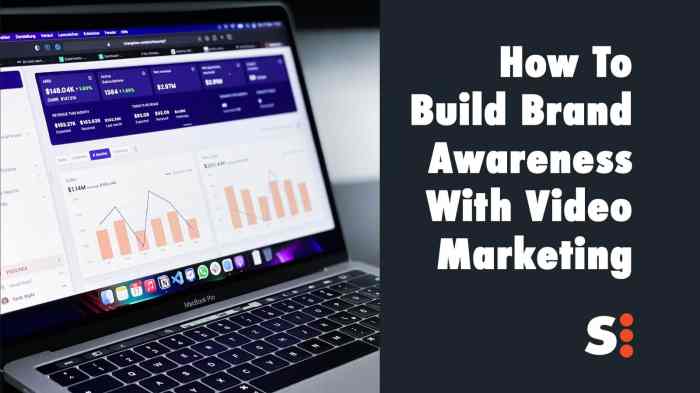Creating Video Content for Brand Awareness sets the stage for a dynamic exploration into the world of visual storytelling, uncovering key tactics and insights to elevate your brand’s presence in the digital realm. Get ready to dive into a high-energy journey filled with creativity and innovation!
From understanding the power of brand awareness through video content to crafting a strategic production process, this topic delves into the core elements that can propel your brand to new heights.
Understanding Brand Awareness through Video Content

Brand awareness refers to the level of recognition a brand has among consumers. It involves creating a strong presence in the minds of the target audience, making them familiar with the brand and its products or services.Video content plays a crucial role in building brand awareness as it allows companies to engage with their audience in a more interactive and dynamic way.
Videos have the power to evoke emotions, tell stories, and showcase the unique aspects of a brand, helping to create a memorable and lasting impression.
Examples of Successful Video Content Campaigns
- The “Share a Coke” campaign by Coca-Cola, where personalized cans with people’s names were featured in a series of heartwarming videos, increased brand awareness and customer engagement.
- Dove’s “Real Beauty Sketches” campaign, which focused on promoting self-confidence and challenging beauty standards, went viral and significantly boosted brand awareness for the company.
- Old Spice’s “The Man Your Man Could Smell Like” campaign, featuring humorous and memorable commercials, helped the brand reinvent its image and attract a younger audience.
Types of Video Content for Brand Awareness

When it comes to creating video content for brand awareness, there are several types that can help businesses reach their target audience and increase visibility. Each type of video content has its own set of advantages and disadvantages, so it’s important to choose the right one based on the brand’s goals and target audience.
Product Demonstrations
Product demonstration videos showcase how a product works, its features, and benefits. These videos are great for educating consumers about the product and convincing them to make a purchase. The advantage of product demonstration videos is that they can help build trust and credibility with the audience. However, the disadvantage is that they may not be as engaging as other types of videos.
Behind-the-Scenes Content
Behind-the-scenes videos give viewers a glimpse into the inner workings of a brand, showcasing the people behind the scenes and the process of creating products or services. These videos can help humanize the brand and create a connection with the audience. The advantage of behind-the-scenes content is that it can build brand loyalty and trust. The disadvantage is that it may not directly promote the product or service.
Customer Testimonials
Customer testimonial videos feature satisfied customers sharing their experiences with a product or service. These videos are powerful because they provide social proof and can help build credibility for the brand. The advantage of customer testimonial videos is that they can influence purchasing decisions. However, the disadvantage is that they may come across as biased if not done authentically.
Explainer Videos
Explainer videos are short, animated videos that explain a product or service in a simple and engaging way. These videos are great for simplifying complex ideas and increasing understanding among the audience. The advantage of explainer videos is that they can improve brand recall and increase conversion rates. The disadvantage is that they may not work well for all types of products or services.
Brand Storytelling
Brand storytelling videos focus on the brand’s history, values, and mission, creating an emotional connection with the audience. These videos can help differentiate the brand from competitors and build a loyal customer base. The advantage of brand storytelling videos is that they can create a strong brand identity. The disadvantage is that they may not directly lead to immediate sales.
Live Videos
Live videos allow brands to interact with their audience in real-time, answering questions and providing exclusive content. These videos can help increase engagement and build a sense of community among followers. The advantage of live videos is that they create a sense of urgency and authenticity. The disadvantage is that they require careful planning and may not reach a large audience at once.
Interactive Videos
Interactive videos engage viewers by allowing them to participate in the content, making choices that affect the outcome. These videos can increase engagement and keep viewers interested for longer periods. The advantage of interactive videos is that they provide a personalized experience for the audience. The disadvantage is that they require more resources and may not be suitable for all brands.
How-To Videos, Creating Video Content for Brand Awareness
How-to videos provide step-by-step instructions on how to use a product or solve a problem. These videos are educational and can position the brand as an expert in its field. The advantage of how-to videos is that they can attract new customers searching for solutions. The disadvantage is that they may not be as shareable as other types of videos.
Planning and Strategy for Creating Video Content: Creating Video Content For Brand Awareness
When it comes to planning and strategizing video content for brand awareness, there are several key steps that need to be considered to ensure a successful campaign.
Aligning Video Content with Brand Identity and Target Audience
It is crucial to align your video content with your brand’s identity and values to maintain consistency and authenticity. Understanding your target audience is equally important, as it helps in creating content that resonates with them on a deeper level.
- Research your target audience demographics, interests, and preferences to tailor your content accordingly.
- Ensure that the tone, style, and messaging of your videos reflect your brand’s personality and values.
- Create a content calendar to plan and schedule videos that align with your brand’s overall marketing strategy.
- Consider using storytelling techniques to engage your audience emotionally and create a lasting impact.
Setting Key Performance Indicators (KPIs)
Setting KPIs is essential for measuring the success of your video content campaigns. It allows you to track the performance of your videos and make data-driven decisions for future strategies.
- Identify specific goals for your video content, such as increasing brand awareness, driving website traffic, or generating leads.
- Choose relevant KPIs to measure the effectiveness of your videos, such as views, engagement rate, click-through rate, or conversion rate.
- Track and analyze your KPIs regularly to assess the performance of your video content and make necessary adjustments to optimize results.
- Use A/B testing to compare different video formats, lengths, or calls to action to determine what works best for your audience.
Production Process for Video Content
The production process for video content involves several stages, from pre-production to post-production, each playing a crucial role in creating impactful videos.
Scripting
Scripting is the foundation of any video content. It involves writing a script that Artikels the dialogue, narration, and actions that will take place in the video.
Storyboarding
Storyboarding is the visual representation of the script, showing how each scene will unfold. It helps in planning the shots, transitions, and overall flow of the video.
Filming
Filming is the actual recording of the video content. This stage involves setting up cameras, lights, and sound equipment to capture the scenes as per the script and storyboard.
Editing
Editing is where the raw footage is transformed into a cohesive and engaging video. It involves cutting, rearranging, adding effects, and enhancing the visuals and sound to create a polished final product.
Sound Design
Sound design is the process of enhancing the audio elements of the video. It includes adding background music, sound effects, and ensuring clear and crisp audio throughout the video.
Brand Consistency
Maintaining brand consistency throughout the production process is essential for creating a cohesive and recognizable brand identity. This includes using brand colors, logos, fonts, and messaging consistently in the video content.
